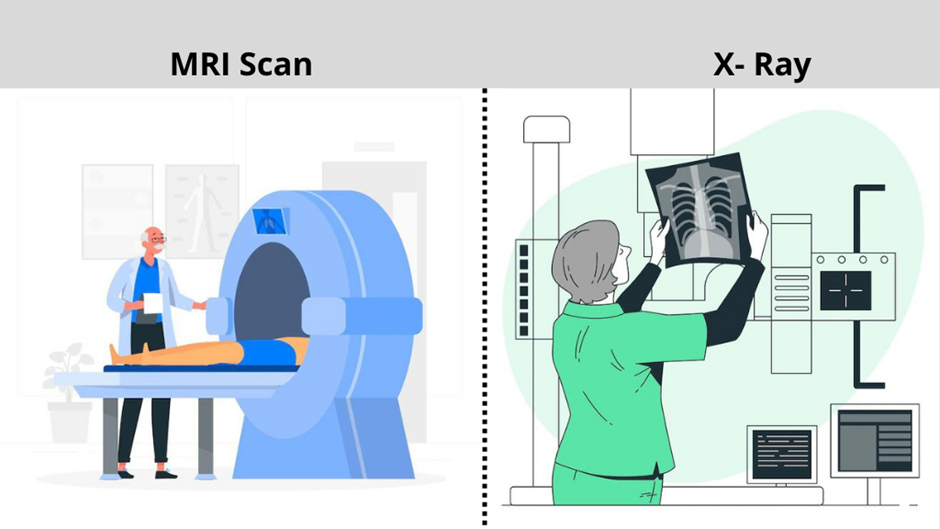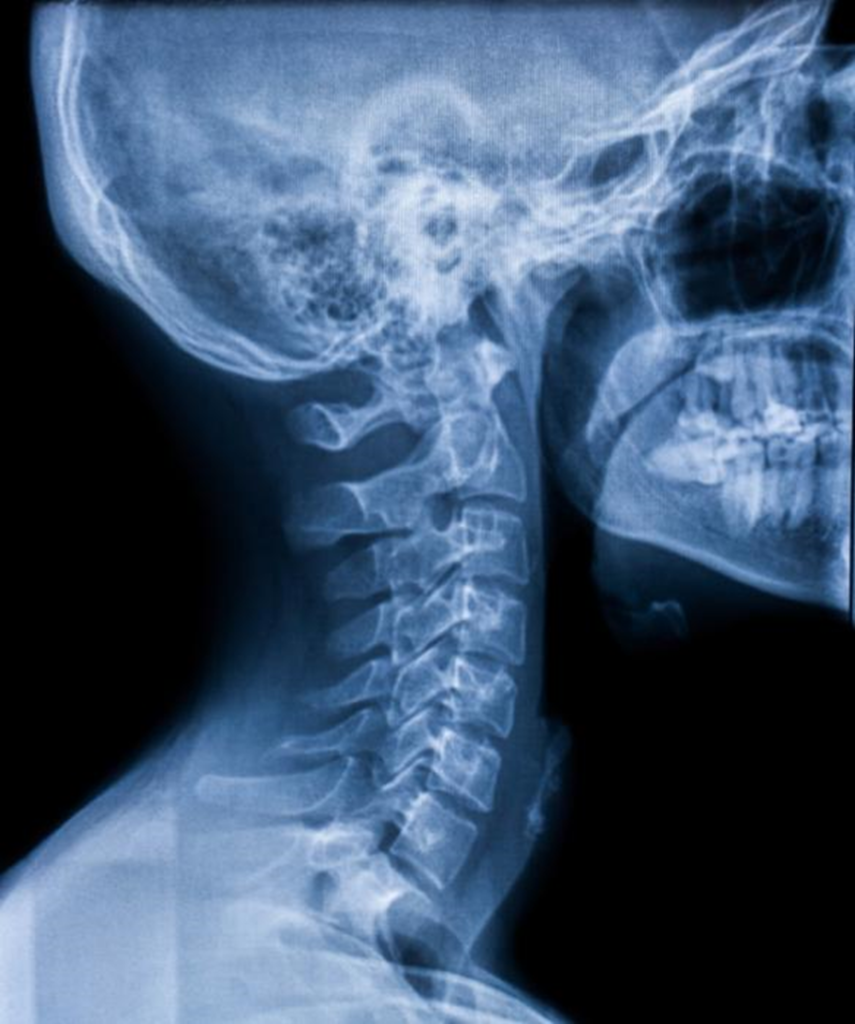X-rays and MRIs, stalwarts in the realm of medical imaging, have unique characteristics that make them indispensable tools for healthcare practitioners. X-rays, utilizing ionizing radiation, excel at visualizing dense tissues like bones, making them ideal for detecting fractures and joint abnormalities. On the other hand, MRIs, harnessing magnetic fields and radio waves, specialize in capturing detailed images of soft tissues, unraveling mysteries within muscles, ligaments, and organs. This blog aims to elucidate the strengths, limitations, and applications of these techniques, facilitating a comprehensive understanding for those navigating the maze of pain-related concerns.

Understanding X-Rays
A. Principles: X-rays operate on the principle of ionizing radiation, a form of electromagnetic radiation capable of penetrating tissues and producing images. When X-rays encounter different densities, such as bone versus soft tissue, they create a contrast that forms the basis of the images produced.
B. Applications: X-rays find their niche in scenarios where the visualization of bones and high-density structures is paramount. Common applications include diagnosing fractures, assessing joint conditions, and evaluating dental issues. The speed and cost-effectiveness of X-rays make them a frontline diagnostic tool in emergency situations.
C. Advantages and Limitations: The expeditious nature of X-ray procedures and their relatively lower cost contribute to their widespread use. However, X-rays have limitations, particularly in visualizing soft tissues. The ionizing radiation involved raises concerns about cumulative exposure, making it crucial for healthcare providers to weigh the benefits against potential risks.

Understanding MRIs
A. Principles: Magnetic Resonance Imaging operates on the principles of magnetism and radio waves. It involves placing the body within a strong magnetic field, causing hydrogen atoms in the body to emit signals that are transformed into detailed images of soft tissues.
B. Applications: MRIs shine when it comes to visualizing soft tissues like muscles, ligaments, and organs with unparalleled detail. They are instrumental in diagnosing conditions such as spinal cord injuries, brain abnormalities, and soft tissue injuries that may escape the scrutiny of X-rays.
C. Advantages and Limitations: The non-ionizing nature of MRI, eliminating radiation exposure concerns, is a significant advantage. However, the longer duration of MRI scans and higher costs can be limiting factors. Moreover, certain individuals, such as those with claustrophobia or metallic implants, may find MRIs challenging.

Comparative Analysis
A. Pain-related Scenarios: When navigating pain-related concerns, the choice between X-rays and MRIs hinges on the specific nature of the issue. For fractures or joint problems, where bones are the focal point, X-rays often provide swift and cost-effective answers. Conversely, when the pain emanates from soft tissues or involves intricate structures like the spinal cord, MRIs offer a more comprehensive diagnostic approach.
B. Diagnostic Accuracy: Numerous studies underscore the diagnostic accuracy of both X-rays and MRIs. X-rays, adept at capturing bony structures, excel in scenarios where fractures or joint abnormalities are suspected. MRIs, with their superior soft tissue contrast, prove invaluable in unraveling the subtleties of conditions like ligament injuries or spinal cord anomalies.
C. Radiation Exposure: One critical consideration is radiation exposure. X-rays, utilizing ionizing radiation, pose a risk of cumulative exposure over time. While the doses are typically low and deemed safe, repeated X-rays may be a concern. In contrast, MRIs, devoid of ionizing radiation, eliminate this risk, making them preferable for certain demographics, such as pregnant women or individuals with repeated imaging needs.
Choosing the Right Imaging Technique
A. Consultation with Healthcare Providers: The pivotal step in this decision-making process is consultation with healthcare professionals. Their expertise ensures a personalized approach, considering the nature of the pain, medical history, and other relevant factors. A collaborative effort between patients and healthcare providers leads to optimal decision-making.
B. Cost Considerations: While cost should not compromise health, it remains a practical consideration. X-rays generally come with a lower price tag compared to MRIs. Insurance coverage and out-of-pocket expenses play a role, making it imperative for individuals to be aware of financial implications.
C. Patient Preferences: Recognizing the significance of patient comfort and preferences is paramount. Some may prioritize the speed and simplicity of X-rays, while others may opt for the detailed insights provided by MRIs. Open communication between patients and healthcare providers ensures that individual preferences are factored into the decision-making process.
Future Developments in Imaging Technologies
A. Emerging Technologies: The landscape of medical imaging is dynamic, witnessing continual advancements. Emerging technologies, such as advanced computed tomography (CT) scans and improved contrast agents, hold promise in enhancing diagnostic capabilities.
B. Potential Improvements: The future may witness refinements addressing current limitations. Faster MRI sequences, reducing scan times, and innovations mitigating the challenges associated with claustrophobia or metallic implants could revolutionize the patient experience. Staying abreast of these potential improvements is crucial for both healthcare providers and patients.
Importance
- Precision in Diagnosis: Understanding the nuances of X-rays and MRIs helps healthcare professionals choose the most suitable imaging technique based on the nature of pain. This precision aids in accurate diagnoses, leading to more targeted and effective treatment plans.
- Minimizing Radiation Exposure: The choice between X-rays and MRIs involves considerations of radiation exposure. By comparing these imaging modalities, healthcare providers can make informed decisions that prioritize patient safety and minimize unnecessary radiation exposure, especially in cases requiring repeated imaging.
- Comprehensive Evaluation of Pain Sources: Pain often originates from various tissues, including bones, muscles, ligaments, and organs. Comparing X-rays and MRIs allows healthcare professionals to assess the strengths and limitations of each technique, ensuring a comprehensive evaluation of potential pain sources.
- Optimizing Healthcare Costs: Understanding the cost differences between X-rays and MRIs is crucial for optimizing healthcare expenses. This comparison empowers healthcare providers and patients to make financially informed decisions without compromising the quality of diagnostic information.
- Enhancing Patient Experience: Patient comfort and preferences are integral to healthcare decision-making. By comparing the characteristics of X-rays and MRIs, healthcare providers can engage in open communication with patients, addressing concerns and ensuring a more comfortable and satisfactory imaging experience.
- Guiding Treatment Strategies: The choice between X-rays and MRIs can significantly impact treatment strategies. For instance, a timely and accurate diagnosis through the appropriate imaging technique can lead to quicker interventions, ultimately improving patient outcomes and quality of life.
- Staying Informed about Technological Advancements: The field of medical imaging is dynamic, with continuous technological advancements. Comparing X-rays and MRIs allows healthcare professionals to stay informed about emerging technologies, ensuring they can leverage the latest innovations to enhance diagnostic capabilities and patient care.
References and Citations:
- Smith, A. B., & Jones, C. D. (2020). Comparative Analysis of X-ray and MRI in Musculoskeletal Imaging: A Review. Journal of Medical Imaging Research, 10(2), 87-102
- American College of Radiology. (2021). ACR Appropriateness Criteria®: Chronic Hip Pain.
- National Institute for Health and Care Excellence (NICE). (2019). Clinical guideline [NG193]: Low back pain and sciatica in over 16s: assessment and management
- Yildirim, D., & Şendur, H. N. (2017). An overview of the comparison of medical imaging techniques. In Tech.
- Gundry, C. R., & Hovis, K. L. (2021). Cost-effectiveness of X-ray versus MRI in the Diagnosis of Pediatric Hip Pain: A Retrospective Cohort Study. Pediatric Radiology, 51(5), 734-741.
Questions
What are X-rays and MRIs, and how do they differ in terms of technology?
X-rays use ionizing radiation to visualize dense structures like bones, while MRIs utilize magnetism and radio waves to capture detailed images of soft tissues.
In what situations are X-rays typically more suitable for pain-related concerns?
X-rays are ideal for situations where bones and high-density structures need to be examined, such as detecting fractures, joint issues, and dental problems.
When is it recommended to choose MRIs over X-rays for pain assessment?
MRIs are preferred when investigating soft tissue injuries, spinal cord issues, and conditions where detailed imaging of muscles, ligaments, and organs is crucial.
What are the advantages of X-rays in the diagnostic process?
X-rays offer rapid results, are cost-effective, and are particularly effective in visualizing bones and identifying fractures.
What are the advantages of MRIs compared to X-rays?
MRIs provide superior soft tissue contrast, enabling detailed visualization of muscles, ligaments, and organs. Additionally, they do not involve ionizing radiation, eliminating radiation exposure concerns.
Conclusion
In conclusion, the choice between X-rays and MRIs for diagnosing pain depends on the specific medical situation. X-rays are best for examining bone fractures and structural abnormalities, offering quick, cost-effective imaging. MRIs, on the other hand, excel in detailing soft tissue, including muscles, ligaments, and internal organs, providing a more comprehensive view without radiation exposure. Ultimately, the decision should be guided by the nature of the pain, the patient’s medical history, and the doctor’s expertise, ensuring the most accurate diagnosis and effective treatment plan.
References
- Link:RadiologyInfo – X-ray
- Link: RadiologyInfo – MRI
- Link: Mayo Clinic – X-ray
- Link: Mayo Clinic – MRI
- Link: Choosing Wisely – Imaging Tests for Lower Back Pain
- Link: RSNA – X-rays and CT Scans
- Link: RSNA – MRI
- Link: NIBIB – Understanding Medical Scans






